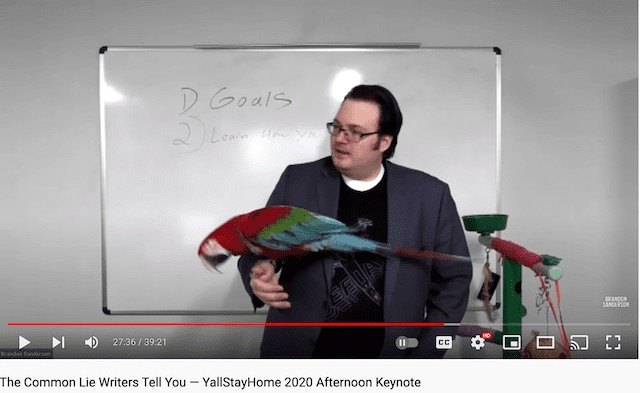Brandon Sanderson, the acclaimed fantasy novelist, delivered a powerful message in his 2020 keynote speech, “The Common Lies Writers Tell You,” that resonates far beyond the realm of writing. Instead of empty platitudes like “you can do anything you want to,” Sanderson advocates for a more realistic and empowering perspective: “I can do hard things. Doing hard things has intrinsic value, and they will make me a better person, even if I end up failing.” This “do hard things” philosophy provides a valuable framework for personal growth and achievement. This study guide explores Sanderson’s three key tips, enhanced with practical insights, to help you tackle your own challenging goals and develop resilience.
 Brandon Sanderson Keynote
Brandon Sanderson Keynote
Tip #1: Craft SMART Goals You Can Control
Sanderson learned early in his career the importance of setting effective goals. His initial ambition to become a professional novelist, while inspiring, lacked the direct control needed for consistent progress. He wrote thirteen novels before selling one. A better approach, he realized, would have been focusing on completing a specific number of novels, with each surpassing the previous in quality, regardless of immediate sales or recognition.
The key takeaway is: “Make goals that you have control over.” This aligns with the principles of SMART goals (Specific, Measurable, Achievable, Relevant, Time-bound). By focusing on actionable steps, you maintain momentum and build confidence.
Consider the difference between these two goals:
- Poor Goal: Get my research paper accepted into a top-tier journal.
- Better Goal: Dedicate 15 hours per week to focused work on my research paper, aiming to complete one high-quality draft per month.
The “better” goal emphasizes consistent effort and skill development, factors directly within your control. This approach mirrors the 4DX methodology’s emphasis on lead indicators: focusing on activities that directly drive desired outcomes.
Tip #2: Understand Your Personal Workflow
Sanderson challenges the romanticized notion that “real writers” are driven by an insatiable, constant urge to write. He acknowledges that even he, a successful novelist, sometimes struggles to sit down and work. This emphasizes that procrastination and resistance are normal parts of the process, not signs of inadequacy.
The real secret lies in understanding what motivates you. Experiment with different strategies to identify the optimal blend of motivation, environment, and accountability. Some writers thrive on tracking daily word counts in a spreadsheet. Others find support and motivation in writing groups. Still others rely on deadlines to trigger productivity. The most important thing is to recognize that the urge to avoid hard things is human, and should be expected.
Furthermore, digital minimalism plays a key role. Reducing screen time and the constant stream of digital distractions can significantly lower the resistance to tackling demanding tasks. If your mind is conditioned to expect instant gratification through endless scrolling, it becomes exponentially harder to focus on meaningful, but challenging, work. Freeing yourself from the clutches of dopamine-driven digital habits creates space for deeper focus and engagement.
Tip #3: Divide and Conquer: Break Down Large Tasks
Sanderson’s final piece of advice emphasizes the importance of breaking down large, daunting goals into smaller, manageable steps. He illustrates this point by noting that his current novel is longer than the entire Hunger Games series. He can only tackle this by working “word by word.”
He wishes he had received a more detailed roadmap when he began his writing journey. Instead of the vague advice to simply “write,” he would have benefited from a structured practice regime centered on writing a series of increasingly ambitious manuscripts, each designed to develop his skills to the point where he was capable of producing sellable work.
This concept translates to any challenging endeavor. Seeking guidance from those who have achieved similar goals is invaluable. Ask them to outline their journey step-by-step, revealing what truly mattered and what didn’t. One of the most common pitfalls is creating a narrative around what you want to be important, rather than what actually drives results. Focus on learning the proven strategies and tactics that lead to success.
Conclusion: Embrace the Power of Doing Hard Things
Brandon Sanderson’s “do hard things” philosophy provides a powerful framework for personal and professional growth. By setting SMART, controllable goals, understanding your personal workflow, and breaking down tasks into manageable steps, you can overcome challenges and unlock your full potential. Don’t be afraid to embrace the difficulty, learn from failures, and celebrate small victories along the way. The journey of doing hard things is not just about achieving a specific outcome, but about becoming a stronger, more resilient, and more capable version of yourself. Now, take the first step towards tackling your own “hard thing.” What’s one small, actionable step you can take today?
